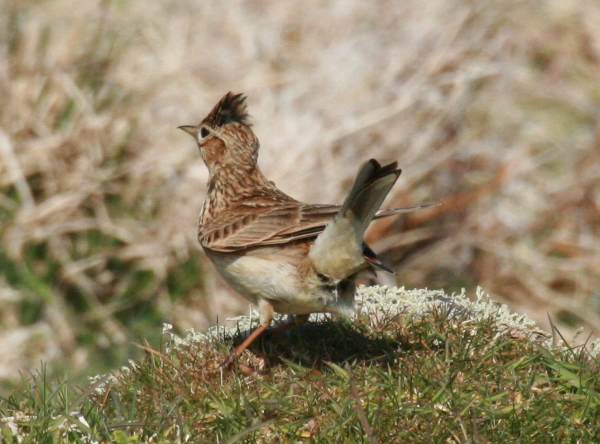Trees Birds Mammals Fish Amphibians Reptiles
Wild Algarve
Bookshop
Alauda arvensis - Eurasian Skylark
Phylum: Chordata - Class: Aves - Order: Passeriformes - Family: Alaudidae
Identification - Distribution - Lifecycle - Food - Predators - Reference Sources

The Eurasian Skylark, a year-round resident in Britain, is the most common of Britain's larks.
Identification
The Skylark is a small, plump, brownish bird, little bigger than a sparrow, with a horn-coloured bill and distinctive crown feathers that can be raised in a crest (the crest is not always visible) and a very varied song that make these grassland birds not only memorable but also very popular even with people who know next to nothing about birds. Males are slightly larger tha females but otherwise very similar. The upperparts of adults are brown, streaked heavily with black, while the underparts are buffish or almost white with the breast streaked with black. The Skylark's outer tail feathers are white, and its legs are yellowish-brown.
Distribution
Eurasian Skylarks are found throughout Britain and Ireland, and their geographical range includes most of Europe and Asia as well as parts of northern Africa.
Lifecycle
In Britain, Skylarks begin breeding in late April on meadows, saltmarshes, heathland and farmland, where the females (mainly) make a cup-like nest on the ground using grass lined with hair. Two or three (occasionally four) clutches of 3 to 5 pale grey eggs, heavy marked with brown-and-olive spots, are incubated for typically just 11 days. Both parents feed the young, which fledge in about three weeks.
Food
The Skylark's main food source is seeds and grain but these versatile little birds will also feed on small insects and grassland spiders when the opportunity arises.
Conservation
In steep decline since the late 1970s, the Skylark population in Britain has already plumeted by more than 70% and seems destined to reduce further unless more farms become wildlife friendly. Not surprisingly, therefore, the conservation status of the Skylark in Britain is 'Red', meaning that their status is of greatest concern. This remarkable songbird has become an icon, highlighting the urgent need to halt and reverse the destruction of natural grassland habitats in Britain and most other parts of Europe.
Predators
The natural lifespan of a Skylark in the wild is typically about four or five years, but if they manage to escape predation (for example by small falcons) Skylarks have been known to attain an age of eight or exceptionally even ten years. Many nestlings are killed not by avian predators but by terestrial enemies such as snakes and foxes.